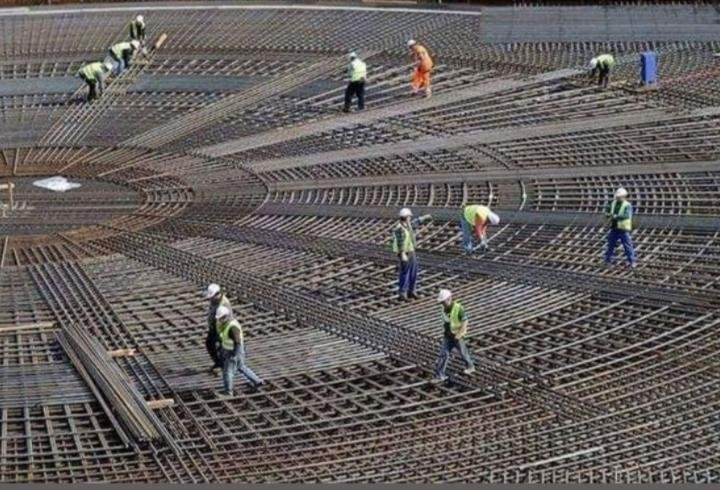What is foundation, you may ask? In engineering, a foundation is the part of a structure that connects it to the ground and transfers the load from the structure to the earth.
Foundation: What are the different types of foundations?
1) Shallow foundation
This kind of foundation is used for a shallow-depth stratum so that load can be transferred to the stratum. A shallow foundation is classified into four broad categories, and they are as follows.
- Isolated footing: Here, below each structure column, a stepped footing is provided, and generally, each step projects 50-75 mm from the previous step and is 3 in quantity. This is used in good-quality soil areas in low-cost buildings.
- Combined footing: Here, two columns have a single type of footing. The clear span between 2 columns is meagre, resulting in overlapping stepped courses if isolated column footings are provided. These are classified into 2 types, rectangular and trapezoidal footings, depending on the same and unequal loads, respectively.
- Cantilever footing: It is combined Footing connected by a tie beam with lower width at greater depth, which helps stabilise columns. It is necessary for conditions where there are strict restrictions on space, thus making a uniform distribution of weights.
- Raft or mat footing: It is used in places where the distance between each column is very less, and also, in this case, the inferior quality of the soil and its lower bearing capacity is the reason for providing common footing beneath each column.
Merits of shallow foundation
- They are the simplest form of foundation and are used to transfer load from the superstructure to the subsoil uniformly.
- The water table is reasonably deep, so there is no need for close application of different waterproofing techniques to the foundation as there is no chance of encountering water at the base.
- This type of foundation needs very less time and thus saves time and cost.
- In this type of footing, the requirement of shuttering material is low, which makes it economical compared to others.
- No skilled labour is required.
2) Deep foundation
This kind is used for deeper depth stratum for load transformation. A deep foundation is classified into two main categories,
- Pile foundation: It is one of the most commonly used deep foundations for building projects. It is also of the following types.
- Compact pile, uplift pile, batter pile, sheet file, anchor pile, or fender pile depending on the nature of the pile.
- Concrete pile, steel pile, timber pile, composite pile, etc., depending on the pile’s material.
- End bearing pile and friction pile depending on load transfer. The former transfers load by bearing and the latter by friction between the pile and the surrounding soil.
- Caisson foundations: Well, the foundation is classified into 3 caissons, namely open, box, and pneumatic caissons, among which the pneumatic caissons are used the most. This type of foundation is mainly found for the construction of bridges, and marine structures, where the soil present at river beds is weak and consists of stones and rubble, forming an uneven surface.
Merits of deep foundation
- This type of foundation is suitable for any place.
- For the construction of underwater and complicated buildings, a deep foundation is implemented because of its high stability and ability to prevent structures from getting affected by settlements and overturning.
Foundation: The purpose of a foundation
- The foundation is necessary for distributing the load of the building over the large base area to transfer into the soil underneath. But one must know the soil’s bearable limit in carrying a load.
- The stability of any structure depends on its foundation. The more robust the foundation, the more stable the structure.
- A proper foundation helps in the uniform distribution of load, which helps avoid unequal settlements of the building at different places because differential settlement is an undesirable building effect.
- Careful construction of the foundation helps in providing a proper surface so that substructure can be developed on a proper level over a firm bed.
- A specially designed foundation helps avoid the supporting material’s lateral movements.
Foundation: Points to remember when a foundation is designed for each structure
- Be careful about the pressure that the soil can withhold.
- Keep in mind the settlement was caused during the first service load.
- The underground soil should not undergo any kind of shear failure.
Foundation: The dimensions of a foundation are as follows
- The height of the foundation is determined using Rankine’s Formula, having a minimum value of 0.9 metres.
- The foundation’s breadth should not be less than 0.45 to 0.5 metres.

Foundation: Things needed for a good foundation
Foundation is necessary for every building, but if one needs to ensure a long-lasting building, one should concentrate on having a good foundation. Now the necessities are;
- A rigid base can easily avoid differential settlement. The occurrence is maximum in areas where the superimposed load is not uniform.
- The sustainability and the transmission of the dead and imposed load to the soil must be done by ensuring that there will be no stability issues in the future.
- The foundation’s chosen location ought to be free from any potential future effects or influences.
- It is always better to have a deep foundation only after finding the nature of the soil and area so that it can protect from any kind of damage or distress. The problem of shrinkage and swelling is often observed due to temperature changes otherwise.
Foundation: Functions of a foundation
- Foundations ensure the chances of structural failure of buildings reduces, and thus it makes the building more durable in adverse conditions.
- The foundation helps prevent or minimise cracks that occur because of the movement of moisture in case of weak soils or soils that have a low capacity.
- The foundation is also the reason for the safety of the structure as it protects the foundation from the adverse effects of undermining and scouring due to animals, flood water, etc.
- The foundation also protects the building from any kind of natural disaster.

Foundation: Historic type of foundations
The foundations we mentioned above are all used in modern times, but there are also some historical types of foundations. They are:
- Post-in-ground or earthfast construction
Even under masonry or stone walls, soft or moist ground was supported by timber pilings. Basically, posts in ground construction do not have any foundation. A mesh of wood or steel beams in concrete used in building a bridge is called grillage in marine construction.
- Padstones
It means a single stone that spreads weight on the ground and raises the timber off the ground. It is one of the simplest kinds of foundations.
- Rubble trench foundations
Foundations made of rubble trenches are small ditches filled with stones or debris. There may be a drain pipe on these foundations, which extend below the frost line and aid in the drainage of groundwater. This kind of foundation is appropriate for soils with a bearing capacity more than 10 tonnes per square metre (2,000 pounds per square foot).

Some other types of footings are as follows. We have already explained some footings when discussing shallow and deep foundations.
- Simple spread footing: Here foundation is constructed, and then the columns. This type of footing is only suitable when there is no excessive load that will come from the upper part.
- Sloped footing: In this type of footing, a foundation base is further supported by a column. But the slope is to connect the base with the column size, which also resembles a trapezoidal shape. It is also called trapezoidal slope footing.
FAQs:
Do we need to know about the foundation of adjacent buildings?
The foundations of the adjacent structure are monitored to not be near the target foundation as it may affect the choice and hinder the process. The safety of the adjoining building is significant as it will affect the decision on the foundation type. It is more challenging if the neighbouring area is an old property or a high-rise building.
What happens if silty soil is chosen?
The foundation depth should be greater than the erosion zone and also than the zone of swelling and shrinkage.
What is needed for a foundation in clay soil?
Collect and drain rainwater and do foundation extension to a depth where no moisture change occurs. Remove the shallow and weak soil layer, such as black cotton soil. Construct in the dry season if possible and make sure of uniform distribution of structural loads.
Source: housing





Can you be more specific about the content of your article? After reading it, I still have some doubts. Hope you can help me.
Can you be more specific about the content of your article? After reading it, I still have some doubts. Hope you can help me.